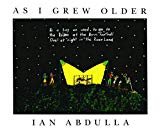
Title
As I Grew Older : The Life and Times of a Nunga Growing up Along the Murray River
Author
Ian Abdulla
Secondary Authors
John Kean
Illustrators
Ian Abdulla
Publisher, Date
Omnibus, 1993
Audience
Primary, Upper Primary
ISBN
1862911606
Language
English
Add to Favourites
-
Subjects
- Aboriginal Australians
- Animals
- Art, Aboriginal Australian
- Autobiographies
- Childhood and youth
- Fishing stories
- Floods
- Indigenous languages
- Missions
- Poverty
- River Murray
- Toys
-
Annotation
Ngarrindjeri man, Ian W Abdulla (1947-2011), grew up in the 1950s along the Murray River at Cobdolga, near Swan Reach, and published two picture books based on his childhood experiences, ‘As I Grew Older’ (1993) and ‘Tucker’ (1994). A third book, ‘Elvis Has Entered the Building’, by Stephen Fox and Janet Maughan, (2003, Wakefield Press) includes other works in museums and galleries.
The autobiographical narrative in ‘As I Grew Older’ is a unique blend of oral storytelling, written transcription and visual imagery. The artist would tell a story, one of his children would write it down, then the artist would inscribe the written text onto the painting he had created. This process offers an interesting challenge for adaptation in book form, because the typeset word text on the page facing the picture and the text hand-painted onto the picture itself are not identical. Because the artist is relating a scene from his own childhood, and has probably told the story many times, he takes some details for granted, so the editor has added words and phrases that help to extrapolate for the reader - particularly the young reader - what is going on.
In addition, spelling mistakes and idiosyncratic grammatical constructions are preserved in the inscribed image, but corrected in the typeset word text. Older readers may be interested to research evolving practices since 1993 in the transcription of Aboriginal Australian English, and other variants that are increasingly accepted as non-standard dialects, rather than ‘wrong’. A comparison with Auntie Elaine Russell’s picture books, with discrete word text and visual image, would be useful. Comparing both artists, young readers may also like to revisit the conventional description of this art style as ‘naive’. To what extent was this term political, and to what extent has it survived, and why?
Readers familiar with non-Indigenous narratives from the 1950s may be surprised at the clear inference of poverty in ‘As I Grew Older’. The artist tells of collecting sheep’s heads from the ‘slaughter yards’, taking them home and skinning them so they could be cooked for the family. Young readers will squirm at his comment that even the sheep’s eyes were eaten. Then the jawbone remaining from the meal would be broken into makeshift toy guns. Similarly he describes in detail the trapping of rats along the river, so their skins could be sold for making into handbags, to create even a minimal income for the family.
Abdulla has spoken of this time as the Depression - a term generally reserved for the severe economic downturn in the western world after 1929. Given the high incidence of unemployment, grief and loss created by the COVID19 pandemic, however, the resilience and optimism of children here in rural Australia in the 1950s will be reframed in the contemporary classroom. For an infamously risk-averse late 20th-early 21st century society, with its ‘helicopter parenting’, the games played by children here will be surprising as they jump onto the ferry at the last minute, fall into the river and consequently miss school, with no hint of regret.
One of the most appealing features of the narrative in ‘As I Grew Older’ is its total absence of either condemnation or self-pity. Abdulla’s ability to relive the resourcefulness and optimism of his childhood, however challenging for the adults at the time, is inspiring. ‘Things were hard, but we would always find ways of bringing in money for food in the home and collecting bottles was one way of beating the hard times.’
Young readers will find it interesting to explore a range of socio-economic and cultural factors that determine perspectives on the advantages and disadvantages of this 1950s childhood. With its celebration of life along the inland waterways, As I Grew Older is a valuable counterpart to the deeply embedded celebration of the coast in non-Indigenous Australian narrative. They will want to juxtapose the generally optimistic view of the Murray here with headline images of fish kills in the 21st century and reasons for the current critical state of the Murray-Darling river system. They may be alarmed at Abdulla’s stories of family expeditions to collect swan’s eggs for food, for example, but may be unexpectedly encouraged by comparing a concluding historical note by John Kean in the book’s end matter on the threatened extinction of the Murray Cod with the culinary interest it is now attracting around the world. Both the map and Kean’s afterword will renew interest in Country that, clearly, too many Australians have neglected.
-
Teaching Resources
- ‘Ian Abdulla’, April 2010, Mendel Art Gallery, Saskatoon, Canada; YouTube (concludes with significant anecdote about being upset when his children were taught dot painting, because it is not part of their tradition) https://www.youtube.com/watch?v=s-ZYJ64VQcI
- ‘Ian W Abdulla: 156 works’ - list compiled by John Murphy, Australia and New Zealand Art Sales Digest (convenient online gallery of scans of individual works, many not included in Abdulla’s picture books ‘As I Grew Older’ and ‘Tucker’) https://www.aasd.com.au/index.cfm/list-all-works/?concat=abdullaian%20w&direction=0&order=0&start=51&show=50
- ‘Ian W Abdulla’, Art Gallery of South Australia (scans of individual works in the gallery’s collection) https://www.agsa.sa.gov.au/collection-publications/collection/works/catching-yabbies/29740/
- ‘Mass Fish Kill: What next for the Darling River community’, Australian Story, ABCTV, January 2019 (although set on the Darling River, the focus here on 21-year-old activist Kate McBride will inspire young readers to research a range of perspectives on the inland rivers) https://www.youtube.com/watch?v=vRI-MsnZuSM
